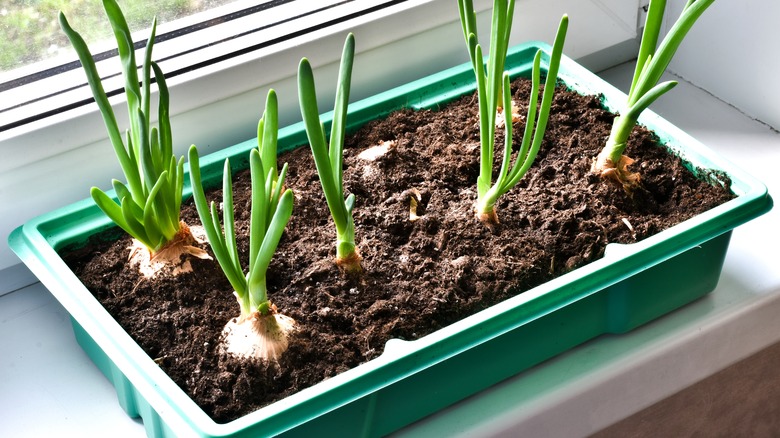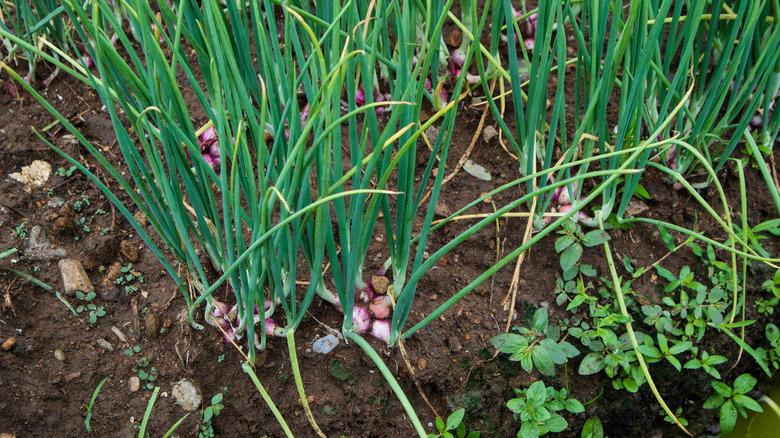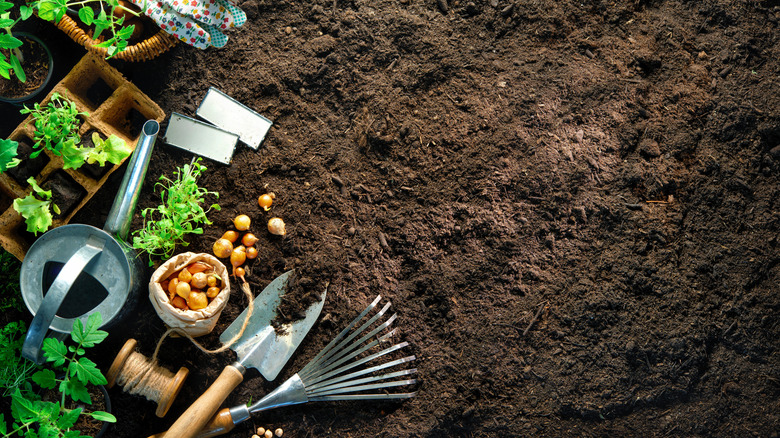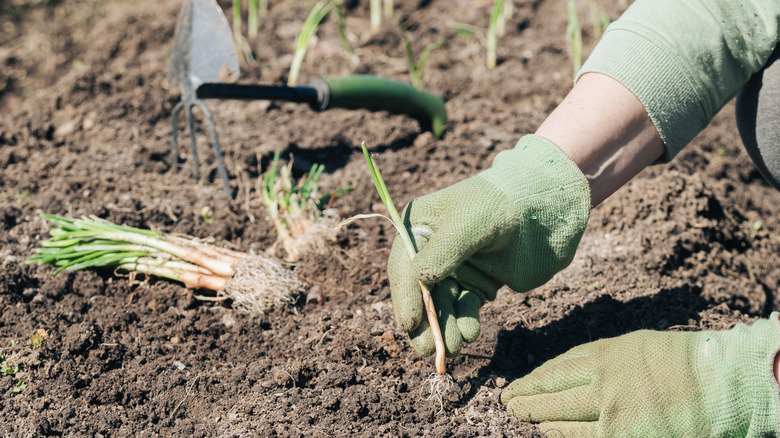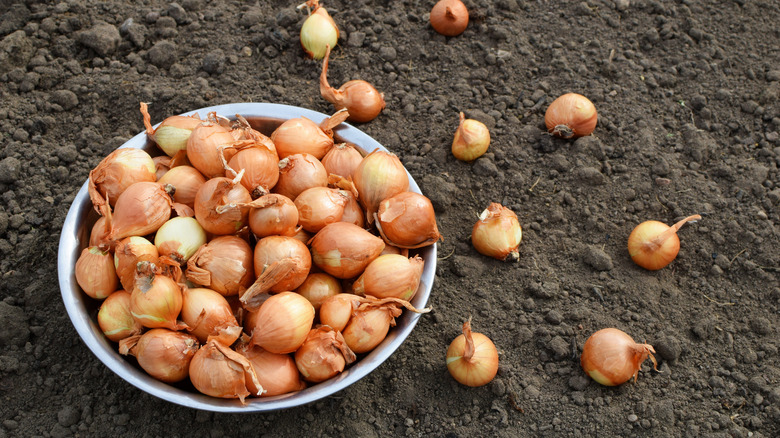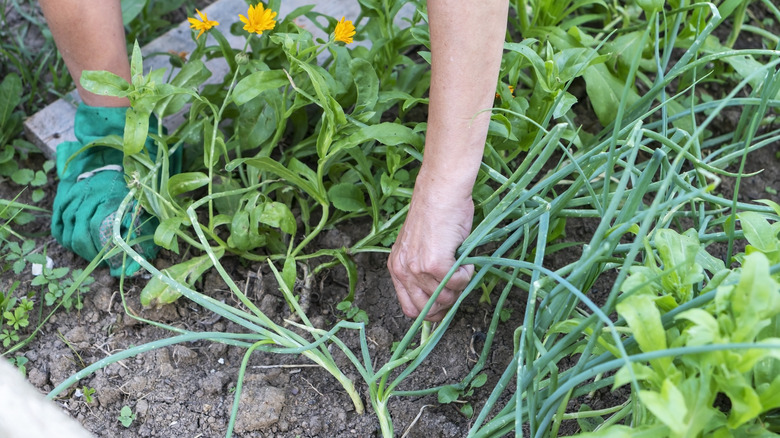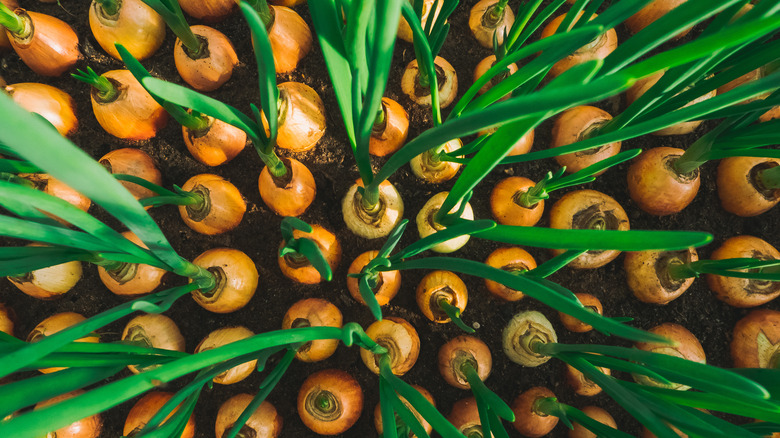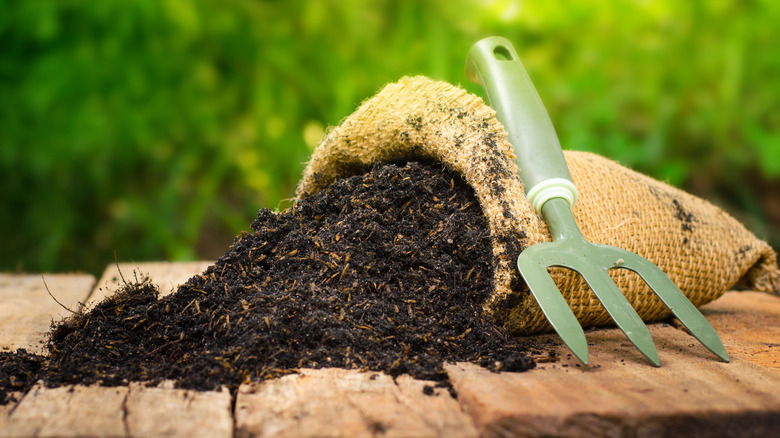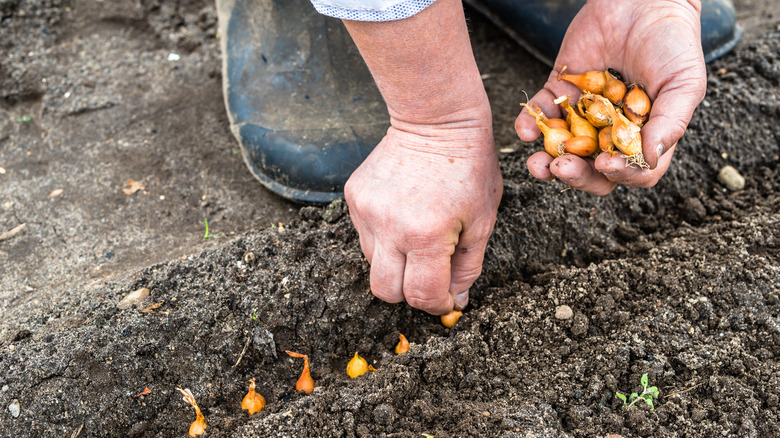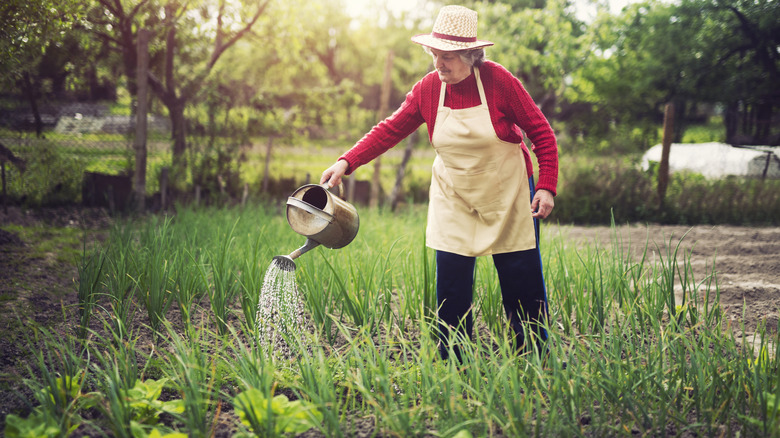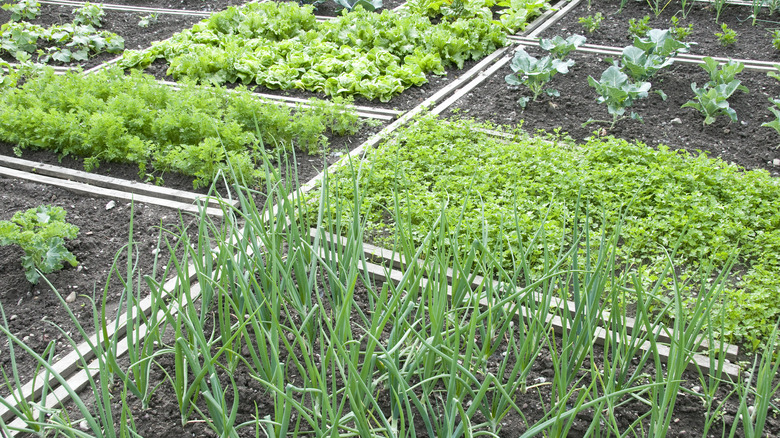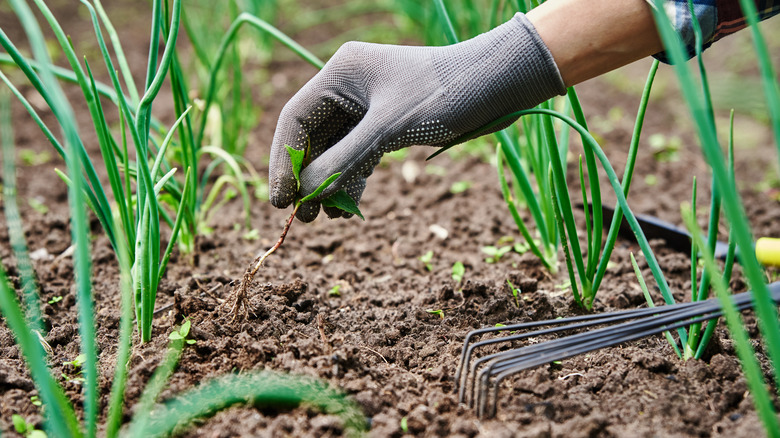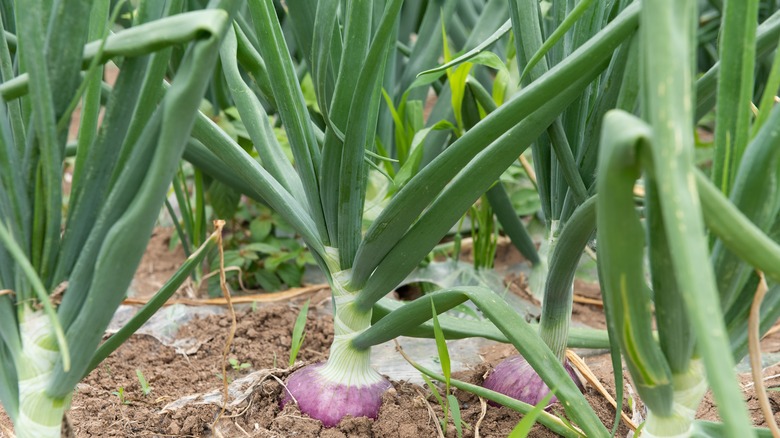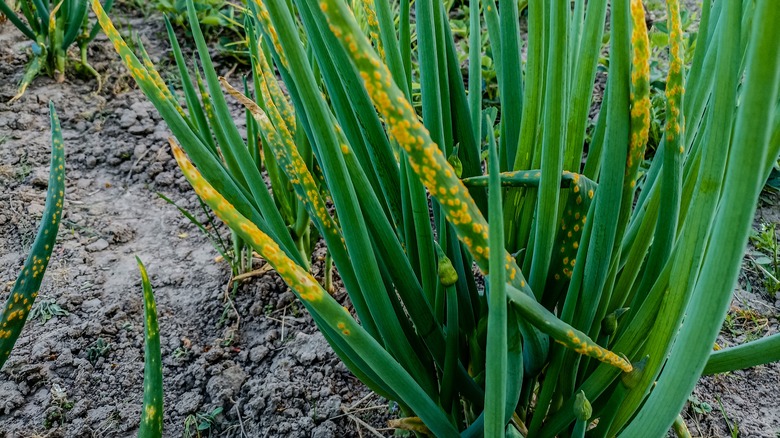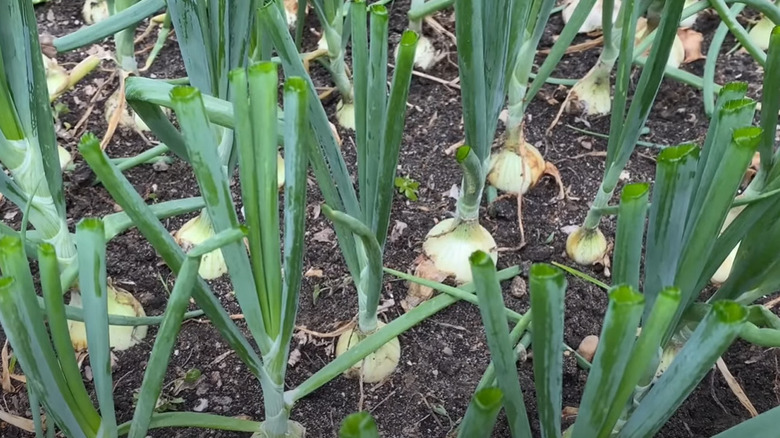Avoidable Mistakes That Are Killing Your Onions In The Garden
We may receive a commission on purchases made from links.
Ah, onions, those subterranean pearls that have graced our dinner tables and cuisines across cultures with their exceptional flavor and health benefits. But do they have to be our grocery list staple? No! Enter onion farming. Tending to your garden and watching the evolution of onions from humble seeds, transplants, or sets to flourishing bulbs fills our hearts with a sense of pride and accomplishment. However, mess up any element of the stipulated onion growing regimen, and you risk turning your potential onion utopia into a scene from a gardener's horror story. Here, we are talking about gardening missteps like planting the wrong variety for your region, ill-timed planting, overcrowding, improper watering, and poor soil preparation.
Onions aren't the priciest produce on grocery store shelves, right? But the satisfaction of growing fresh onions organically cannot be understated. There lies a world of difference between the taste of a store-bought onion and one that's lovingly cultivated in your garden. Fortunately, establishing a thriving, eco-friendly onion patch isn't a far-fetched dream. By substituting chemical fertilizers for natural alternatives like manure or compost and swapping out synthetic insecticides and fungicides for household staples like baking soda and ground cinnamon, your sustainable onion garden is well within reach. Now, with the basics spotlighted, how about we explore common onion farming mistakes and ways to sidestep them?
Planting non-adapted varieties
Imagine the sight of tiny, underachieving onions where you expected vibrant, juicy bulbs. This sad spectacle often springs from a fundamental onion-growing mistake: planting varieties poorly adapted to your local climate. While the fault partially lies with local garden centers supplying ill-suited types, the core responsibility rests on you to choose a suitable variety. You must first understand the intricacies of short-day, long-day, and day-neutral varieties. As Bruce L Frasier, President of Dixondale Farms, advised Homes & Gardens, "Planting a short day in the north will not generate enough leaves before the bulbing will begin, and therefore will produce golf ball size onions as best."
Incorrect planting time
The philosophy of timing is strikingly accurate when applied to planting onions. Misjudge the right time to introduce your onion seeds or sets to the soil, and your seemingly insignificant error could reverberate down the growth cycle, affecting development and yield. There's a delicate balance to attain, which many keen gardeners have discovered springing into action in spring. Plant during this window when the soil becomes cooperative, and the air still carries a whiff of winter chill. By understanding your region's annual rhythm and harmonizing it with your planting efforts, you can count on your onions to reward you with a lush, postcard-worthy yield.
Choosing unsuitable planting method
The decision between onion sets vs. seeds vs. transplants isn't merely about personal preference; it decides the fate of your crop. Each method has pros and cons, and understanding how they align with your gardening conditions, climate, and selected onion type can't be understated. For instance, onion sets or transplants give your growth process a running start in colder climates, beating the short growing season. However, while sets are the most straightforward route to nurture onions, they can be heavier priced and limited in diversity. Conversely, cultivating onions from seeds, which typically have a lifespan of one year, requires first sowing them at least 2.5 months before the optimal transplanting window.
Planting oversized sets or transplants
In the world of onion gardening, an oversized set or transplant is not a sign of strength or potential. It's a ticking time bomb that, instead of growing into a big, delicious bulb, might race headlong into adulthood and prematurely flower. This phenomenon, called 'bolting,' causes the onion to drain its energy into flower production at the expense of bulb development. Choosing the right size of onion sets or transplants is not about grabbing the biggest of the lot; instead. Understanding that smaller, rightly sized transplants promise healthier bulb growth. If you intend to plant transplants, don't wait for them to bloat beyond a pencil's diameter.
Nurturing onions in shaded areas
Onions are the sun-worshippers of the vegetable world, craving a minimum of 11 hours of direct sunlight. Forcing them to grow in shady corners goes against their preference, resulting in subpar bulb growth. In some cases, you may witness prolific leaf growth, with bulbs remaining a mere fantasy. It's not just about bulb size. Studies have shown that onions grown in sunny areas are richer in flavonoids celebrated for anti-neuroinflammability properties. Maximizing sunlight absorption requires strategic planting when other crops are involved, though. For example, ensure taller companion plants cast their shade only when the onions have basked in ample sunlight and are well into their later growth phase.
Overcrowding the onions
Don't human societies value personal space? The "Onion Society" is no different. Stuff them too close together, and you kick off an unseen survival mission, with each onion battling its neighbor for resources like sunlight, water, and nutrients. This silent but fierce competition typically stunts growth and causes onions to produce smaller bulbs. The secret to healthy, full-sized bulbs? Give your onions their breathing room. Paying attention to proper spacing, around 3 to 4 inches between individual plants and 12 to 16 inches between rows, lets each onion plant claim its share of resources for a robust and satisfying harvest.
Poor soil quality
Another typical mistake when growing onions is overlooking your soil's health. Subpar soils sabotage root proliferation, giving rise to frail plants and underachieving bulbs. But treat your onions to a soil reminiscent of a beach holiday — well-draining, sandy-loamy soil rich in organic matter and with a slightly acidic pH range of 6.0 to 7.0 — and you'll see the difference. Compacted soils could be improved with the help of nutrient-rich amendments like bone meal and blood meal or organic matter such as compost, aged manure, or peat moss.
Planting onion too deep
Most of us have been there, making that rookie onion-growing mistake of sending the sets or transplants too deep in relation to the earth's mantle. What happens is simple but disastrous. Rather than focusing on yielding plump, juicy bulbs, the plant channels energy into pushing out leafy greens, leaving you with sorely underdeveloped bulbs. Even worse, the buried depth can cause no end of despair when cold, wet weather hits, basically sending an open invite for rot. When planting, delicately nestle the sets or transplants 1 to 1½ inches deep — only a smidge of soil should cover the tips of the set bulbs.
Watering mishaps
Here's something you probably know: onions have shallow root systems, which makes their thirst for water more particular than most other vegetables. However, overwatering can be just as bad as underwatering, and both can be the death knell for your onions. Waterlogged conditions? Cue the rot and fungal diseases. Grave drought? Wilting, stunting, and mediocre bulb sizes become your nemesis. Normally, ensure water reaches an inch down per week, but increase the frequency during dry spells. However, hold your watering hoses off if the weather is wet or when bulbs mature and the leaves assume a shade of yellow.
Planting onions only all year round
Planting onions every year? Such monotonous rhythms could instigate a symphony of troubles (including pest infestations, poor soil structure, and nutrient depletion) within your green haven. Like a skillful conductor, alternate between planting onions and other hearty vegetables to replenish your soil's nutrients. Deep-rooted vegetables like tomatoes, cucumbers, and sweet potatoes provide the perfect relief after a season of growing onions. However, beware of introducing legumes like beans and peas in succession to onions, as they become susceptible to lurking soil-borne growth inhibitors. Lastly, let it be known that onions and asparagus don't harmonize as companion plants.
Ignoring weed control
Under their innocent appearance, weeds are bandits robbing your onions of essential growth nutrients, water, and light. This is a battle onions often lose because their inherent competitive spirit is quite low. Instead of leaving the vegetables to this "David-Goliath" contest, take that hoe or carefully selected organic herbicide and show the weeds who's boss. However, while mechanical weeding tools are recommended for younger onion plants, rough-handed use could cause damage to the bulbs. As the plants mature, protection against weeds and detrimental temperature fluctuations will suffice in the form of a black plastic mulch. A worthy contender would be the Agfabric Landscape Fabric for $54.68 on Amazon.
Covering up onion bulbs that are popping out
Now, let's delve into the surprising scenario of onion bulbs surfacing from the ground. The sight might incite visions of hilling up those exposed wonders for protection — after all, it's a tactic we typically enlist for some vegetables like potatoes. However, not all vegetables march to the same beat. Onions, when mature, are surface dwellers that vigorously resist being buried completely. Covering the bulbs bulging out of the earth won't protect them. Instead, it encourages excessive moisture retention, which rolls out a red carpet for rot. Therefore, resist the urge, as popping out is simply the onion's way of growing.
Disregarding disease and pest symptoms
Have you heard of purple blotch, downy mildew, blight, fusarium basal rot, white rot, or onion smut? Letting any of these diseases run amok screams doom for your onion garden. And let's not ignore the pests, including thrips, onion maggots, and eel-like nematodes — they are small but mighty in destructive power. With an eagle-eyed approach, you can spot the telltale signs swiftly and act promptly to safeguard your plants. Attention to proper plant spacing, crop rotation, and water management can reduce disease likelihood significantly. An integrated pest management plan could involve insecticidal soaps, horticultural oils (neem oil), and other organic control measures.
Topping the onion foliage
Last on our list of onion farming mistakes is a misconception that promises bulkier onion bulbs. The associated belief theorizes that snapping those green tops forces the plant to reallocate its resources to the bulb beneath. However, the truth is quite the reverse. The leaves play an essential role in bulb formation by manufacturing essential sugars (thanks to photosynthesis) and transferring them to the bulbs for growth and maturation — trimming them off damages the very system vital for onion maturation. Instead, allow nature to take its course, letting the greens fall naturally when your onions are mature.
